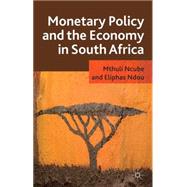
Monetary Policy and the Economy in South Africa
by Ncube, Mthuli; Ndou, Eliphas-

This Item Qualifies for Free Shipping!*
*Excludes marketplace orders.
Buy New
Rent Textbook
Rent Digital
Used Textbook
We're Sorry
Sold Out
How Marketplace Works:
- This item is offered by an independent seller and not shipped from our warehouse
- Item details like edition and cover design may differ from our description; see seller's comments before ordering.
- Sellers much confirm and ship within two business days; otherwise, the order will be cancelled and refunded.
- Marketplace purchases cannot be returned to eCampus.com. Contact the seller directly for inquiries; if no response within two days, contact customer service.
- Additional shipping costs apply to Marketplace purchases. Review shipping costs at checkout.
Summary
Author Biography
Eliphas Ndou works at the South Africa Reserve Bank Research Department as an economist in the monetary policy research unit. He lectures international finance and microeconomics at the University of Witwatersrand, South Africa.
Table of Contents
1. South African Monetary Policy Regimes
2. Effects of Monetary Policy on Output
2.1. Introduction
2.1.1. Theory and Past Empirical Evidence
2.2. VAR Methodology
2.3. Data
2.3.1. How do Variables React upon Impact?
2.5. Empirical Results
2.4.1. Examining the Relationship between Estimated Policy Shocks and Recessions
2.5. Conclusion
3. Inflation Uncertainty and Output
3.1. Introduction
3.2. Theory
3.2.1. The Friedman Hypothesis
3.2.2. The Impact of Inflation Uncertainty on Inflation
3.2.3. Inflation Uncertainty, Real Output Growth, and Output Growth Uncertainty
3.3. Literature Review
3.4. Econometric Methodology
3.4.1. The Relationship between Inflation and Inflation Uncertainty
3.4.2. The Inflation Uncertainty and Real Output Growth
3.5. Data and Descriptive Statistics
3.6. Empirical Results
3.6.1. VAR Methodology
3.7. Conclusions
4. Monetary Policy Transmission, House Price and Consumption
4.1. Introduction
4.2. Consumption, Housing Prices and Interest Rates
4.2.1. The Effect of Monetary Policy on House Prices
4.2.2. The Effects of House Prices on Consumption
4.3. The VAR Model
4.4. Data
4.5. Results and Discussion
4.5.1. Forecast Error Variance Decomposition
4.5.2. Robustness Analysis
4.5.3. Discussion of Consumption Declines Results
2.5. Conclusion
Appendix: Quantifying Declines in Consumption
Unit Root Tests
5. Monetary Policy, Disposable Income and Consumption
5.1. Introduction
5.2. Data
5.3. VAR Model
5.4. Results 66
5.5. Impact of Oil Price in the Extended Model
5.6. Counterfactual Analysis
5.7. Variance Decompositions
5.8. Conclusions
6. Mortgage Variables, Monetary Policy and Consumption
6.1. Introduction
6.2. Theory
6.3. What does International Evidence Conclude?
6.3. Data
6.4.1. Bayesian VAR Approach
6.5. Results
6.5.1. Contractionary Monetary Policy Shock
6.5.2. Mortgage Lending Rate or (Negative Credit Supply) Shock
6.5.3. Housing Demand Shock
6.5.4. Residential Investment Shock
6.5.5. Variance Decompositions
6.6. Examining Impact of US Mortgage Variables on South Africa
6.6.3. Variance Decomposition
6.7. Conclusion
7. Monetary Policy and Exchange Rate Shocks on South Africa Trade Balance
7.1. Introduction
7.2. Literature Review
7.3. VAR Methodology
7.3.1. Benchmark VAR Model
7.4. Data
7.5. Empirical Results
7.5.1. How are Policy Shocks Transmitted into Trade Balance?
7.6. Variance Decomposition
7.7. Conclusion
8. Exchange Rate, House Prices and Equity Shocks on Current Account
8.1. Introduction
8.2. Review of Findings in Other Countries
8.3. VAR Methodology
8.4. Data
8.5. Empirical Results
8.5.2. Forecast Error Variance Decompositions
8.6. Conclusion
9. International Transmission of US Shocks into South Africa
9.1. Introduction
9.2. A Review of Previous Empirical Analysis
9.3. VAR Methodology
9.4. Data
9.5. Results
9.6. Conclusion
References
An electronic version of this book is available through VitalSource.
This book is viewable on PC, Mac, iPhone, iPad, iPod Touch, and most smartphones.
By purchasing, you will be able to view this book online, as well as download it, for the chosen number of days.
Digital License
You are licensing a digital product for a set duration. Durations are set forth in the product description, with "Lifetime" typically meaning five (5) years of online access and permanent download to a supported device. All licenses are non-transferable.
More details can be found here.
A downloadable version of this book is available through the eCampus Reader or compatible Adobe readers.
Applications are available on iOS, Android, PC, Mac, and Windows Mobile platforms.
Please view the compatibility matrix prior to purchase.
